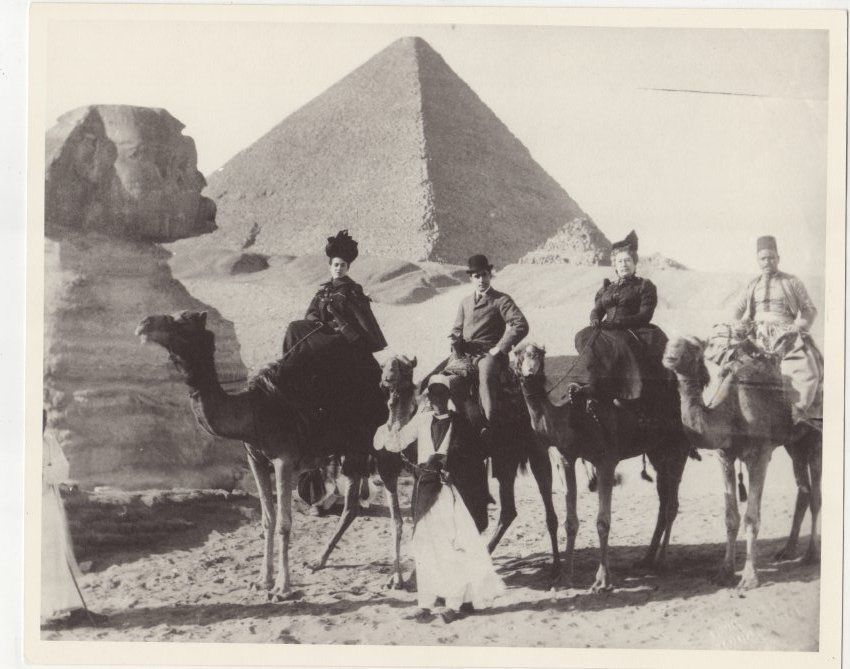Peggy Derrick
Photo by Roger Grant-Copyright La Crosse County Historical Society
One of the best parts of giving tours at Hixon House, La Crosse’s premiere historic house museum, is getting to show off the home’s Turkish Nook.
It always gets lots of “oohs and ahhs” from visitors who are enchanted by its beauty and amazed that it is such an old decorating scheme, going back to the late Victorians.
Eastern-themed rooms existed long before Pier-One Imports or the fad for draping Indian “bedspreads” about a room to give it an exotic look. In the latter half of the 19th century, travel to the Middle East became increasingly affordable and safe, and affluent Americans began making the trip in large numbers. Their travels and the souvenirs they brought home helped feed the American fascination with the “exotic east,” and the decorating trend that encouraged Oriental rooms and “nooks,” such as the one in Hixon House.
This historic photo includes, from left, May Crosby, Joseph Hixon, Ellen Hixon and an Egyptian guide.
In 1898 and 1899, Ellen Hixon added Turkey and Egypt to the European Grand Tour she made with her niece Mary Crosby and son Joseph. A widow by then, with five grown sons, Ellen Hixon enjoyed travel and was lucky to be able to afford it. We have a photo of her and her companions atop camels by the Great Pyramids, and letters that describe shopping in the bazaars and purchasing some of the items that make up the décor of the Turkish Nook.
It’s a small room, added in 1900-01, that serves as an elegant pass-through to the dining room. The built-in bench is upholstered in antique Kilim woven carpets, with embroidered pillows. The walls and ceiling are gold (gold leaf, in the case of the ceiling), and decorated with antique Persian weaponry and period photos of the streets of Cairo. Stained glass windows let in light and help create an exotic atmosphere.
By far the most commented-on item is the standing wooden lattice screen to the right of the photo. “What is that?” people always ask, and telling them it’s a “harem screen” just adds to the confusion.
In fact, wooden lattice screens were common enclosures on Egyptian balconies and in courtyards; they allowed light and air to pass through while preserving the privacy of Muslim women who lived with strictures against being seen by strange men. The lattice screens allowed them to observe and participate in the life of the street and courtyard while maintaining their religious rules.
The screens themselves are intricate and beautiful, and to the curious Westerner, they symbolized the mysteries of a private world that was hidden from them but imagined to be quite exotic and titillating — hence the Western name, harem screen.
This fascination with the mysteries of the east had a bit of a risqué touch. One historian, Karina Corrigan, writes that the Victorian image of the Near East was one of “turbaned men smoking hashish in hookahs and their many wives lounging on divans, gazing longingly out of the latticed windows of harems.” Mrs. Hixon may well have been showing off her sophistication by having such a suggestive item in her “Oriental room.”
By the 1920s the fad for the Turkish style in home décor was fading. It became symbolic of heavy-handed Victorian excess, and Oriental rooms and cozy corners were replaced with more modern styles. The risqué Turkish Nook appeared old-fashioned, fussy and quaint. They began to disappear.
The Turkish Nook in the Hixon House is a rare, fragile survivor of what was once a very popular style of decorating. Since the 1960s, we have seen Near and Far Eastern textiles and décor come back into fashion, used is somewhat different ways than in the 1890s-1910s. But La Crosse’s Turkish Nook has survived long enough to be “cool” again.
This article was originally published in the La Crosse Tribune on December 1, 2018.



